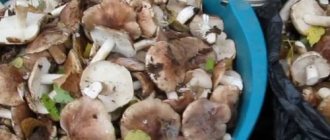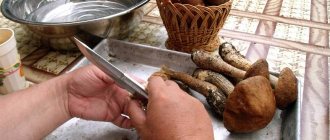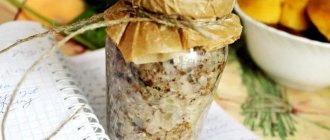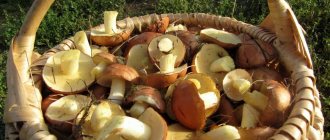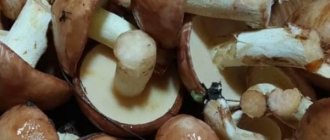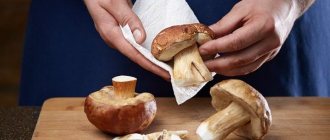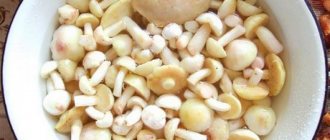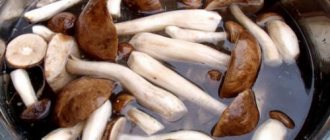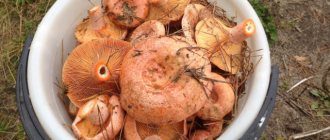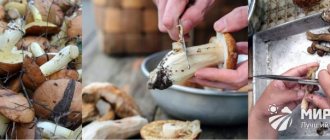Read also: How to grow gladioli for early flowering
- Do they clean boletus in the forest or at home? Still, it is better to carry out the main process of removing the coating at home, since immediately after this it will need to be prepared.
At the same time, do not procrastinate; when you arrive home, immediately begin processing.
From the moment of collection to the start of processing, no more than 12 hours can pass. It is better if the fruits spend most of this time in the refrigerator.
- If it rained the day before and the crop is wet, dry it on a newspaper for several hours.
- There is no need to soak the mushrooms in the hope of removing the sticky layer faster. The porous structure of the body absorbs water and then it is impossible to work with it.
So, the briefing has been completed, it’s time to get down to the fun part.
Is sticky mushroom juice dangerous?
Milky sap is a white liquid that flows out when the fruiting body is wounded. In some cases, this may mean that the mushroom that was cut is poisonous. But, there are many edible varieties that secrete this very milky juice. The list includes: milk mushrooms, camphor milkweed, saffron milk cap, milkweed, pink trumpet. All mushrooms require soaking, otherwise they are completely unusable.
The milky juice makes the mushrooms bitter and not at all beneficial for the human body. First of all, before you start cooking, you should make sure that the chanterelle or butter dish that is to be cooked is not false. You should also be careful with mushrooms containing milky juice; most of them are conditionally edible and should not be eaten without special preparation.
“Vodka” salad with mushrooms and pickles. We recommend trying the “Vodka” salad even for those who do not drink strong drinks at all. Dish…
In order to prepare a mushroom with this “seasoning”, you need to thoroughly clean it, remove the top layer from the cap, clean the inside, under the cap, cut off all excess and rinse the resulting material, take a pan, fill it with cold water. Leave the peeled fruits for several days, constantly changing the water, the more often the better. You can add salt and a little citric acid, but this is not necessary. And only after this procedure begin cooking. The only exception is saffron milk caps - their juice is not bitter at all and they do not require soaking.
Using these simple rules and tricks, you can greatly simplify your work. Having cleaned the boletus quickly, you will soon be able to try dishes prepared from them.
Habitats
In total, about 60 species of boletus are known, which belong to the genus of edible tubular mushrooms. Of these, the most common in Central Russian forests is the late oiler. The richest harvests of this species occur in September-October.
Summer butterdish is unique in that it is suitable for consumption even in its raw form, and is found in coniferous forests from May to July.
Larch boletus grows among deciduous and cedar pines, the harvest season of which falls on all three summer months.
Why do you need to remove the skin from the caps of butterfish?
Butterflies are universal mushrooms, since they can be used to prepare any dish with the addition of vegetables, meat, cheese, eggs, and also make any preparation for the winter: dried, pickled, salted, fried, stewed and frozen.
However, having brought boletus from the forest, you need to know how to process it correctly. The process itself is labor-intensive, especially due to the slippery skin of the mushroom. In this case, the question arises: why clean the oil from the film at all?
To understand why you need to clean the caps of boletus mushrooms, you need to familiarize yourself with the structural features of these mushrooms. Each type of mushroom has its own structure, taste and benefits. Butternuts are beautiful fruiting bodies rich in vitamins and amino acids. They can improve digestion, relieve headaches, and their enzymes even help in restoring the body after acute respiratory viral infections and acute respiratory infections. But the mucous film on mushroom caps collects debris, accumulates toxic substances and radiation. Therefore, removing the top layer of the oil can cap is mandatory, despite the fact that this process causes a lot of trouble during initial processing. In this material you will learn useful recommendations on why you need to clean the caps of butterflies, and how to do it.
For example, if you remove the skin from the cap of a butter dish, you can say for sure that there will be no debris in the prepared dish; we will not hear the crunch of sand or earth on our teeth. Small specks, remnants of grass and leaves stick very firmly to the oily cap. Therefore, by removing it, we can guarantee the cleanliness of our future workpiece.
Oils can be soaked in water to remove most of the dirt. Then why remove the film from the oils if you can just wash them well? Note that soaking is allowed only after removing the oily skin from the mushroom cap. Staying in water for a long time has a bad effect on unrefined boletus; they quickly absorb liquid, becoming watery. Then processing these mushrooms will seem like “a real hell” to you. Wet boletus is very difficult to pick up and hold in order to clean it. They become so slippery that you need to become a virtuoso to remove the film from them.
Important Rules
The butterdish got its name from the characteristic oily skin on the cap, which is the natural protection of a forest dweller. However, it is this thing that provides the most difficulties for lovers of quiet hunting.
Before you learn how to clean boletus correctly and quickly, familiarize yourself with the basic rules, the implementation of which will simplify your work.
- First of all, make sure that it is the oiler in front of you. If you hold in your hands a specimen with a yellow-brown or brown-olive cap covered with an oily mucus that comes off easily, congratulations - you have caught the right animal.
- Consider cleaning while still in the forest. Shake as much needles and leaves into the lids as possible.
- Trim the bottom of the stem right away to avoid taking home excess dirt.
- Do not take wormy mushrooms, no matter how large and attractive they may seem to you. They won't be of any use, but they will be able to ruin healthy samples.
- Do they clean boletus in the forest or at home? Still, it is better to carry out the main process of removing the coating at home, since immediately after this it will need to be prepared.
- At the same time, do not procrastinate; when you arrive home, immediately begin processing.
From the moment of collection to the start of processing, no more than 12 hours can pass. It is better if the fruits spend most of this time in the refrigerator.
- If it rained the day before and the crop is wet, dry it on a newspaper for several hours.
- There is no need to soak the mushrooms in the hope of removing the sticky layer faster. The porous structure of the body absorbs water and then it is impossible to work with it.
So, the briefing has been completed, it’s time to get down to the fun part.
Why do they clean the film of butter before cooking?
The best option remains dry cleansing, without using liquid. They can be scalded with boiling water or simply allowed to dry. In this case, the film on the cap can be removed very easily with a knife.
Butterflies are usually cleaned for reasons of the aesthetic appearance of the mushroom. Peeled boletus looks white and beautiful, after boiling it retains its color and does not release mucus. If you fry boletus with the skin, it easily sticks to the pan and the mushrooms lose their shape. That's why they clean the film of butter before any preparations.
Why are boletus peeled before freezing?
Many people are interested in why boletus is peeled before freezing? The fact is that after defrosting, unpeeled mushrooms become so slippery as if they had been in water for a long time. Such butter will give the dish a bitter taste and the consistency of jelly, and this is not always necessary for cooking.
Why do you peel the skin of butterfish if you need to make soup? This is simply necessary for the taste of our dish. The soup will have a pleasant aroma of wild mushrooms, a delicate, soft consistency without mucus and sticky viscosity, which makes it tasteless.
Interesting facts about boletus
- The calorie content of butter is only 19 kcal, which makes it an ideal dish for those losing weight;
- The British and Germans consider boletus poisonous and fear them like fire;
- Boletus contains the highest amount of vitamin D;
- Oil beetles are found throughout the world, including Africa and Australia;
- Butterflies grow in groups towards the sunny side;
- Butterflies do not like moisture, so they grow even in deserts;
- The most productive mushroom month is August;
- Butterflies were artificially planted in Chernobyl after the accident at the nuclear power plant to reduce the level of radiation;
- Oily mucus can dissolve insects that mushrooms feed on in the tropics.
Subject:
- Useful tips
- edible mushrooms
Is it necessary to clean the oil from the film?
Before cleaning, you need to decide what kind of dish you plan to get from mushrooms. If they are used in fried, stewed or canned form, then it is necessary to peel the film from the butternuts.
Before cleaning, you need to familiarize yourself with useful recommendations:
- The cleaning process begins with the cap, smoothly moving to the stem.
- The thin skin of young specimens does not need to be removed unless you are confident in the authenticity of the species.
- Before cleaning, the mushroom crop is not soaked, since the tubular layer quickly absorbs liquid.
- After getting rid of mucus, the mushroom collection is washed under running water.
- Cleaning the harvested crop is a long and labor-intensive process, so it is better to involve all family members in the work.
- The work is carried out with rubber gloves, since the dark stains that appear on the skin of the hands when cleaning remain for a long time.
Why do you need to remove the film from the oil?
Before preparing mushroom dishes, housewives often wonder whether it is necessary to remove the film from the mushrooms or whether it is enough to simply rinse them under running water.
Why you need to peel butternuts:
- During ripening, the oil skin absorbs harmful substances and unpleasant odors.
- Unskimmed mucus can give the finished dish a bitter taste.
- Peeled, snow-white mushrooms look more beautiful when preserved.
- When harvesting unpeeled mushrooms, the brine becomes dark in color.
- In young specimens, a dense, snow-white cover covers the bottom of the cap, therefore, in order not to mistakenly pick up false mushrooms, it is necessary to remove the film from the boletus to see the tubular layer.
- When cooked, the mucous membrane that is not removed swells, thereby spoiling the appearance of the prepared dishes.
Is it possible not to remove the film from the oil?
Mushroom collection is often used fresh and for preparing preparations for the winter. Drying is carried out in rare cases, since the forest products begin to crumble after heat treatment. Mushroom powder can be used to make sauces and pureed soups.
To clean or not
To understand whether it is necessary to clean boletus at all, decide on their fate. What will you cook from this storehouse of protein?
For example, if you plan to dry it, then it is not at all necessary to clean the oil from the film; it is enough to remove all the adhering debris using a brush with stiff bristles, and scrape the stem with a sharp knife.
If you cook or fry, cleaning is necessary, because during the cooking process the protective skin will become rough, unsuitable for chewing, and will also add bitterness to the finished product.
You should not wash them before work, because all the debris will only become more ingrained. Rinse after you have removed all excess.
How to quickly clear the film from boletus immediately after collection
To avoid bringing excess garbage into the house, the harvest can be processed in the forest. Dry, sunny weather is suitable for this. On a rainy day, cleaning in the forest is not carried out, as the mushrooms become slimy and slippery. Having brought them home, they are scattered in 1 layer and dried until the moisture completely disappears.
The film from the boletus cap can be removed in the following way:
- The hat is cleaned of plant debris.
- A vertical incision is made to the film.
- The 2 halves are pulled apart in different directions and quickly pulled up by the sticky skin. If you get used to it, the shell can be removed easily and quickly.
How to quickly remove the film from boletus after drying mushrooms
You can easily remove the slimy skin after drying the mushrooms in the sun. To do this, the sorted specimens are laid out on a baking sheet covered with parchment. The mushroom collection is exposed to open sunlight until the moisture completely disappears. When drying in the shade or partial shade, the process increases by several hours. After the moisture has evaporated, the mucous membrane is lifted with the tip of a knife and carefully removed from the cap. After cleaning, the mushrooms are washed and cooked.
Answers from experts
You need to remove the skin from the cap because it is not tasty when marinated.
Why else is this??
I never peel it, but it still turns out delicious.
I always remove the skin. The mushrooms are not slobbery and look like porcini mushrooms. The peel comes off very easily, you need to pick up more of the edge and preferably gloves, because your hands turn brown
Yes, yes, the skin of the cap must be removed! Removable easily: pry the edge with a knife and pull. They take them off so that they are not slobbering, they look better without her, and most importantly /I heard somewhere/: there is something harmful in her. I'm always filming.
I'm filming. Usually you pry it with a knife and take it off. It’s somehow easier for me to remove than to scrape the dirt off of them
Be sure to remove from the cap using circular movements
I take pictures from big ones, but not from small ones. In marinades it becomes “snotty”.
Because it's easy to remove :)
this is not necessary. It’s not worth it for salting at all, it doesn’t look very good
For example, I fry them together with the caps and I’m still alive and well! Very tasty!
They become “snotty” in the marinade. But I only like it when the mushrooms are small.
To prevent the skin from trailing behind the mushroom when eating, it was probably a very squeamish housewife or her squeamish husband who came up with the idea of removing the skin.
Traditionally, we have marinated butter without skin - white, the marinade is light. If you marinate unpeeled ones, the marinade turns out pinkish. The taste doesn't change.
https://grib-info.ru/spravochnik-gribnika/zachem-nado-chistit-maslyata.html
https://fermilon.ru/sad-i-ogorod/griby/nado-li-chistit-maslyata-ot-plenki-kozhitsy-zachem-snimat-originalnye-sposoby.html
How to quickly remove the film from butter using boiling water
If you need to clean the oil from the film, you can use boiling water. There are 2 ways to quickly clean:
- Pour water into a shallow pan and bring to a boil. The sorted specimens are dipped with their caps into boiling water and transferred to a clean bowl. After such a “bath”, the film is quickly removed from the cap.
- Water is poured into the container. After boiling, the dried mushroom collection is placed in a colander and kept over steam for about 30 seconds. After this procedure, the mucous membrane is removed very easily.
Let's get to work
I hope you already understand how good it is to clean boletus when they are fresh. Now choose the method you like.
With a knife
The most obvious method. Using the blade of a knife, pry the skin at the end of the cap and gently pull it to the other edge.
Experienced mushroom pickers also advise lubricating the lid with vegetable oil, supposedly this will protect the film from tearing.
By the way, the oil will keep your hands from dirt sticking to them. However, if you are particularly concerned about your manicure, start working with gloves.
Without a knife
If it so happens that you don’t have a knife at hand (although it’s hard to imagine a mushroom picker without your main weapon), or you’re interested in trying other methods, you should clean the butterflies with gauze. Place the mushroom headdress on a piece of fabric and pull the edge.
The grooved surface will do the job.
Another option is incredibly simple. Break the catch in half into a film and move the halves in different directions. True, this way the original appearance will be lost.
Boiling water to help
How can you peel boletus mushrooms with boiling water if there were recommendations above not to wet them? Logical question. And here's your answer.
Select a portion of mushrooms and place in a colander in a water bath for 30 seconds. After steam treatment, the film is removed very quickly.
Shock therapy can also be performed. Place the same portion in a colander in boiling water for five minutes, and then pour cold water over it several times.
We use vinegar
To clean the oil from the film using vinegar, boil it with water. You will need a ratio of 3-5 tbsp. l. per liter of water. In a colander, dip the babies in the solution for half a minute and begin removing the sticky layer.
You can also wipe the cap with a vinegar solution using a sponge, this will help neutralize the mucus. Afterwards all that remains is to remove the dirt.
If you didn't bother to protect your hands in advance and your fingers turn black, wipe them with a sponge dipped in vinegar or lemon juice.
How to peel boletus with salt
This method is used if it is necessary to get rid of dirt and parasites. Since salt opens the pores, as a result you can get rid of worms and even the smallest impurities. Add 150 g of coarse salt per liter of water. Cleaned specimens are immersed in a saline solution for 20 minutes, after which they are washed under running water. If there were worms in the harvested crop, then in salt water they will float to the surface, and the eggs will settle to the bottom.
How to quickly peel the skins of boletus using vinegar
Butterflies are tasty and healthy mushrooms. The basket can be filled in a short period of time, as they often grow in families. But when you come home with a large basket, you can spend a lot of time cleaning. There are many different ways to quickly remove the mucous membrane from the cap. One of them is the use of table vinegar:
- Bring 1 liter of water to a boil, add 4 tbsp. l. vinegar. Next, drop the mushrooms in portions into boiling vinegar water for 20 seconds. Treated specimens are cleaned of dirt and mucous skin. Thanks to vinegar, the dirt will come off and the mucous membrane will be easily removed.
- A household sponge is moistened with a weak vinegar solution and the cap is thoroughly wiped. This method easily removes mucus and film from the surface. After removing the oil shell, the mushroom collection is immersed in water for 10 minutes to remove sand and dirt. You can add a pinch of salt to the water, this will drive the worms out of the pulp and get rid of the larvae.
How to quickly remove the skin of butter with a paper napkin
To quickly get rid of mucus from the surface of the cap, you can use a paper napkin folded in 4 layers. Cover the hat with a napkin and press down firmly. A few seconds later, after the napkin sticks to the mucous membrane, they begin to gently pull back the paper edge, as a result of which the film will separate along with the paper. When using this method, you need to stock up on a large amount of paper napkins.
To have an idea of how to quickly clear oil from the film, you can watch the video:
